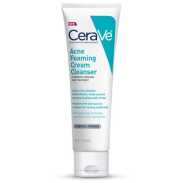Comparison between CeraVe Acne Foam Cream Cleanser vs. Kiehl’s Ultra Facial Cleanser
Find out which product is better for your skin.
Ingredients in both products 5
Components only in CeraVe Acne Foam Cream Cleanser 25
Benzoyl Peroxide, Sodium Methyl Cocoyl Taurate, Coco-Betaine, Sodium Cocoyl Isethionate, PEG-100 Stearate and 20 more. Show all.
Uniqueness: 83.3%
Components only in Kiehl’s Ultra Facial Cleanser 25
Sodium Laureth Sulfate, Decyl Glucoside, Cocamidopropyl Betaine, Disodium Cocoamphodiacetate, Acrylates Copolymer and 20 more. Show all.
Uniqueness: 83.3%
Face to Face
Components position by position
1
Benzoyl Peroxide
1
Water
2
Water
2
Sodium Laureth Sulfate
3
Glycerin
3
Decyl Glucoside
4
Sodium Methyl Cocoyl Taurate
4
Glycerin
5
Coco-Betaine
5
Cocamidopropyl Betaine
6
Sodium Cocoyl Isethionate
6
Disodium Cocoamphodiacetate
7
Sodium Chloride
7
Acrylates Copolymer
8
PEG-100 Stearate
8
PEG-200 Hydrogenated Glyceryl Palmate
Show others
Positive Effects
Find out what good effects the product has
Both products provide the following effects: Antioxidant, Moisturizing, Cleansing, Softening, Soothing, Anti-aging, Lightening, Rejuvenation, Antiseptic, Deodorant, Hair conditioning, Hair structure improvement, Hair gloss
Effects unique for Acne Foam Cream Cleanser:
Acne fighting, Pore Shrinking, Elasticity improvement, ProtectionEffects unique for Ultra Facial Cleanser:
UV Protection, Lifting, Nutrifying, Regeneration, Hair strengthening, Hair growth stimulating, Hair follicle nutrition-- Show more --
ECO Metrics
Find out how eco-friendly the components are
Vegan
No
No
Cruelty free
No
No
Reef safe
Yes
Yes
Ozone layer safe
Yes
Yes
Organic score
natural
8 out of 30
27%
chemical
18 out of 30
60%
natural
11 out of 30
37%
chemical
17 out of 30
57%
Concerns
Pay attention to this information
-- Extra information --
Components by Skin Type
Find out what components are good or bad for your skin type
Dry skin
Positive: 2Negative: 1
Glycerin#3Sodium Hyaluronate#20Benzoyl Peroxide#1
Oily skin
Positive: 0Negative: 1
Glyceryl Stearate SE#14
Sensitive skin
Positive: 0Negative: 0
Dry skin
Positive: 4Negative: 1
Glycerin#4Prunus Amygdalus Dulcis (Sweet Almond) Oil#26Tocopherol#28Persea Gratissima (Avocado) Oil#30Sodium Laureth Sulfate#2
Oily skin
Positive: 0Negative: 2
Prunus Amygdalus Dulcis (Sweet Almond) Oil#26Persea Gratissima (Avocado) Oil#30
Sensitive skin
Positive: 2Negative: 1
Prunus Amygdalus Dulcis (Sweet Almond) Oil#26Prunus Armeniaca (Apricot) Kernel Oil#27Citric Acid#20

